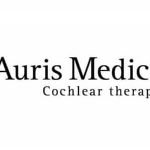See also our coverage of hair cell regeneration, some of which which includes stem cell applications.
November 2005 – Stem cells could cure deafness in ten years.
November 2005 – You may remember Stefan Heller as the researcher who identified stem cells within the inner ear back in 2002. Following his discovery, the idea of treating hearing loss using stem cells really took off. Dr. Heller has just moved his lab to Stanford to take advantage of California’s progressive views on stem cell research. Here’s the press release, which includes a good overview of his current work and his plans for future research.
August 2006 – Stem Cells May Be Key To Deafness Cure
December 2006 – First blood and bone stem cell research on deafness
February 2007 – Stem Cell Transplants Possible Hearing Loss Treatment
February 2007 – Tech Could End Deafness
April 2007 – Cochlear Stem Cells May Lead to Repaired Hearing
June 2007 – Stem Cell Therapy Recovers Lost Hearing
October 2007 – Stem Cell Research Reveals Improved Hearing Possible
September 2008 – Deafness Research UK excited about gene therapy breakthrough
September 2008 – Umbilical Stem Cells May Repair Damaged Cochlear Hair Cells
January 2009 – First Embryonic Stem-Cell Trial Gets Approval From the FDA
March 2009 – New Stem Cell Therapy May Lead to Treatment for Deafness
April 2009 – Stem cells may help deaf people hear
August 2009 – Cord Blood Stem Cells Repair Mouse Inner Ear
November 2009 – Stem Cells Cure Hearing Loss?
January 2010 – Recent Advances in Biological Restoration of Hearing
May 2010 – Deafness cure breakthrough as scientists create tiny ear hairs from stem cells
May 2010 – Scientists create functional inner-ear cells
June 2010 – Stem cells can possibly re-establish hearing
July 2010 – Researchers Cook Up First Recipe for Functional Hair Cells from Stem Cells
February 2011 – Nasal Stem Cells Could Tackle Childhood Hearing Problems
May 2011 – Hair Cell Regeneration Update from Dr. Stefen Heller
October 2011 – Vitro Develops Novel Stem Cell Technology for Use in Treatment of Hearing Loss
January 2012 – First FDA-Approved Study of Stem Cells to Treat Hearing Loss Begins
January 2012 – AFA Denounces FDAs Approval of Newborn Stem Cell Experimentation
February 2012 – Clinical Trials Study Cord Blood Stem Cells to Help Treat Hearing Loss
Stem cells could cure deafness in ten years.
Scientists at Britain’s Sheffield University are hoping that stem cell research could lead to a cure for deafness within ten years! Laboratory tests have demonstrated that embryonic stem cells have the capability to regrow in damaged areas; animal testing is planned within two years.
Stem Cells May Be Key To Deafness Cure
August 2006
In a dusty, cluttered lab at Stanford University, a team of young scientists is on a quest. Curing deafness is the goal, reports CBS News correspondent Elizabeth Kaledin, and Stefan Heller says stem cells hold the key. Heller and his entire team were recruited away from Harvard, and they’ve made a breakthrough discovery: They’ve found that stem cells have the capacity to regenerate in the inner ear.
~~~~~~~~~~~~~~~~~
First blood and bone stem cell research on deafness
December 2006
Deafness Research UK is funding a new research programme that will be the first to try and develop a cure for deafness using stem cells taken from umbilical cord blood or bone marrow. This three-year project will be based in the Centre for Stem Cell Biology at the University of Sheffield and has been made possible by a £126,000 charitable donation from GlaxoSmithKline (GSK). It will be the first research to use these promising new lines of stem cells, which are less controversial than stem cells derived from human embryos, in the search for a cure for deafness. Full Story
~~~~~~~~~~~~~~~~~
Tech Could End Deafness
February 2007
“We have a good chance of getting normal hearing back in normal ears,” said Richard Schmiedt, an otolaryngology professor at the Medical University of South Carolina. The stem-cell approach involves restoring the tiny “hair cells” in the ear that convert sound into electrical impulses. When the cells die, people permanently lose their hearing. Bringing back the cells through stem-cell transplants, along with a shock of electricity, could restore hearing, scientists say. At Stanford University, professor Stefan Heller, who discovered stem cells in the inner ear, believes they can be used to cure deafness in mice within five years. Heller and his colleagues are trying to learn from birds, which do not become deaf, the secret genetic recipe for warding off hearing loss. Full Story
~~~~~~~~~~~~~~~~~
Stem Cell Therapy Recovers Lost Hearing
June 2007
Stem cells injected into the inner ear survived in half of the injured rats, where they migrated away from the site of injection toward the injured region within the inner ear. These stem cells divided in the new environment and expressed several proteins necessary for hearing, suggesting tissue-specific differentiation. Further, transplanted cells that migrated to the damaged area of the inner ear displayed shape similar to that of cochlear fibrocytes. Importantly, transplanted rats exhibited faster recovery from hearing loss, particularly in the high frequency range, which is difficult to restore by natural regeneration. Stem cell migration into the damaged area of the inner ear improved hearing of high frequency sound (40 kHz) by 23% compared to natural recovery in untreated animals. Full Story
~~~~~~~~~~~~~~~~~
Umbilical Stem Cells May Repair Damaged Cochlear Hair Cells
September 2008
According to an Italian research team publishing their findings in the current issue of Cell Transplantation (17:6), hearing loss due to cochlear damage may be repaired by transplantation of human umbilical cord hematopoietic stem cells (HSC) since they show that a small number migrated to the damaged cochlea and repaired sensory hair cells and neurons. For their study, the team used animal models in which permanent hearing loss had been induced by intense noise, chemical toxicity or both. Cochlear regeneration was only observed in animal groups that received HSC transplants. Researchers used sensitive tracing methods to determine if the transplanted cells were capable of migrating to the cochlea and evaluated whether the cells could contribute to regenerating neurons and sensory tissue in the cochlea. Full Story
~~~~~~~~~~~~~~~~~
First Embryonic Stem-Cell Trial Gets Approval From the FDA
January 2009
In a watershed moment for one of the most contentious areas of science and American politics, the U.S. Food and Drug Administration cleared the way for the first-ever human trial of a medical treatment derived from embryonic stem cells. Geron Corp., a Menlo Park, Calif., biotechnology company, is expected to announce Friday that it received a green light from the agency to mount a study of its stem-cell treatment for spinal cord injuries in up to 10 patients. The announcement caps more than a decade of advances in the company’s labs and comes on the cusp of a widely expected shift in U.S. policy toward support of embryonic stem-cell research after years of official opposition. “This is the dawn of a new era in medical therapeutics,” said Thomas B. Okarma, Geron’s president and chief executive officer. The hope that stem-cell therapy will repair and regenerate diseased organs and tissue “goes beyond what pills and scalpels can ever do.” Limits on stem-cell research, which prevented federal funding and were imposed by Congress and former President George W. Bush for ethical and religious reasons, have had a chilling effect on both academic and corporate research involving such cells. Proponents of stem-cell research say restrictions have delayed development of promising new treatments, while critics contend that harvesting stem cells from embryos destroys human life. Full Story
~~~~~~~~~~~~~~~~~
Stem cells may help deaf people hear
April 2009
Stem cells may help deaf people hear again, according to early stage research by British scientists. A team at the University of Sheffield said on Thursday they had discovered how to turn stem cells into ones that behave like sensory hair cells or auditory neurons, which could then be surgically inserted into the ear to restore lost hearing. Lead researcher Marcelo Rivolta said the approach, which is being tested on animals, held significant potential but was a long way from being offered to patients. Full Story
~~~~~~~~~~~~~~~~~
Cord Blood Stem Cells Repair Mouse Inner Ear
August 2009
Results: The authors found that HSC migrated and engrafted into the cochlea of the deaf mice and that the levels of engraftment correlated with both the severity of damage and the treatment dose. Analysis at 60 days post-treatment showed that the mice in the HSC treatment group had well-repaired cochlea with dramatic hair cell regrowth, while control mice showed no sign of repair or hair cell regeneration.
Conclusion: The study shows dramatic repair of cochlear damage in mice after intravenous infusion of cord blood HSC, suggesting a potential therapeutic strategy using cord blood stem cells in hearing rehabilitation therapies. Full Story
~~~~~~~~~~~~~~~~~
Stem Cells Cure Hearing Loss?
November 2009
Currently, stem cell transplant is not allowed in some countries like the United States, some European countries, and South Korea unless it gets a market approval through clinical trials as new pharmaceutical drugs undergo. Chloe had to travel outside of the United States and to Japan or China where (the treatment facility) established stem cell clinics. More than 2,000 patients with various diseases have been treated with stem cell therapeutics through (the treatment facility) since 2008. Chloe’s hearing was tested two months after the procedure was completed on October 16, 2009. The results were spectacular. The left ear improved to 50% from 0%. The right ear gained almost complete hearing. Full Story
~~~~~~~~~~~~~~~~~
Deafness cure breakthrough as scientists create tiny ear hairs from stem cells
May 2010
Scientists have made delicate ear cells in a dish paving the way for a cure for deafness. Grown in their thousands, the delicate hairs could be transplanted into the inner ear, restoring hearing to millions. Some confidence-zapping balance disorders could also be eased, the researchers believe. The breakthrough – which comes after 10 years of painstaking research – could also speed the search for new drug treatments that could prevent people from becoming hard of hearing. Age-related hearing loss affects one in two Britons aged 60 and over and there is currently no way of holding it at bay. Although it is often dismissed by younger people as a minor irritation, it can have a devastating effect on self confidence and cause sufferers to become socially isolated.




